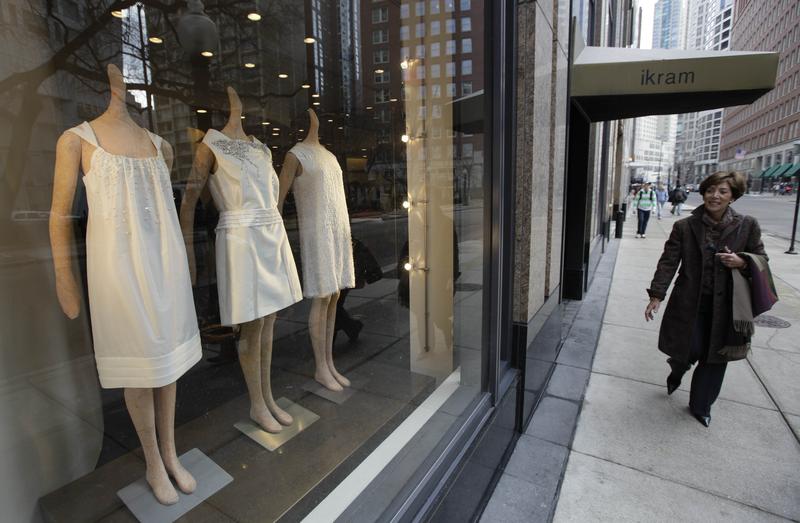Why Are Clothes Suddenly So Expensive?

( AP Photo/M. Spencer Green,File )
[music]
Brigid Bergin: It is The Brian Lehrer Show on WNYC. Welcome back, everybody. I'm Brigid Bergin filling in for Brian today. Inflation over the past few years has made a lot of things so much more expensive from your streaming subscriptions to services like haircuts and especially food. One thing that has held steady until recently is clothing. A new article in The Cut explains how regular clothing brands, which used to be mid-tier in terms of pricing, are now struggling to stay competitive with fast fashion. That can lead to not only artificially high prices, but also cutting corners when it comes to fabric and design.
Joining us now to explain what's going on is Chantal Fernandez, features writer who covers fashion for The Cut. Her latest piece is titled, Why Does A Simple Summer Dress Cost So Much Now? Chantal, welcome to WNYC.
Chantal Fernandez: Hi, Brigid. Thank you so much for having me.
Brigid Bergin: Listeners, I'm wondering who out there has noticed this simultaneous hike in clothing prices. Maybe you're shopping for a big event like a summer wedding or summer work clothes. Have you noticed pricing go up and maybe the quality of those items go down? If you're in the market for a certain item, do you have any tips or tricks on how to find the best deal? Give us a call and share your story. The number is 212-433 WNYC. That's 212-433-9692. You can also text at that number. We're talking about how much more expensive clothing is just recently.
Chantal, you write, "In fashion where pieces stood still for decades the sticker shock often feels more like a jump scare." Can you tell us more about that moment that the fashion industry is in right now? How much have fast fashion brands like Shein or Zara changed the industry?
Chantal Fernandez: Oh man, they've changed it so much. I would argue that we were overdue for a price increase, but basically from the 1990s until 2020, the average price of clothing in the US had not increased at all, and even in some cases, had gone down while prices of the average consumer goods had gone up. Part of the reason behind that is the rise of fast fashion brands.
American shoppers, in particular, are just addicted to cheap fashion thanks to these companies who have-- because of manufacturing their clothing abroad at cheaper prices with cheaper fabrics, deliver us a huge amount of styles and quantities of clothing at really low prices. You're left wondering like, "Why should I spend $300 on a dress when I can get the same thing for a fraction of the price at a place like Zara or Shein or something that looks really similar?"
The less we pay for clothing, the less we worry about how long it will last, which reinforces this same idea, if you only spend $10 on a shirt, doesn't matter if a year from now you need to throw it out and get another one. It's conditioned us to see clothing in this really disposable way and keep buying it, which only reinforces the idea that we should pay less for it, that it's not worth our money.
In addition to that, I think people are reacting rightly to notice that clothing feels cheaper than it did several decades ago. Part of that is brands are competing against these fast fashion giants and competing against this notion that clothing should be cheap. The quality has gone down to accommodate that.
Brigid Bergin: Chantal, when we talk about, or when you write about, so-called normal brands that are cutting back where they can on fabric design, what are we considering those normal brands? Are we talking J.Crew, Gap or something else more mid-tier, like Brooks Brothers or even Ralph Lauren?
Chantal Fernandez: I think all of those. It can also be a small or medium-sized brand that you see on Instagram that has a designer behind it. Basically a brand that's not just selling based on price and speed to market, a company that's trying to build a reputation around creativity or fabrics. It can be the mid-level brands that I think have had to really adjust their business models in the last couple of decades because that middle of the market is just a really tough space to be, because again, people can really easily trade down to something cheaper that's not made as well. You have to make a really strong argument for like, "Why are you paying an extra $50 or $100 for this item?"
We've seen this in a lot of other industries, but being in that middle zone is really tough. We've seen a lot of those middle brands either go up closer towards the luxury higher designer end or try to cut corners and come down and be slightly better than fast fashion, regular fast fashion model, even though you could argue that it's very similar production methods for everyone, but it's a question of what is going into that product. What are you getting when you pay for it?
Brigid Bergin: I want to go to the phones. Let's go to Madeline in Manhattan. Madeline, thanks for calling.
Madeline: Sure, my pleasure. I simply want to say buy used clothing. There are thrift shops all over the place. There are secondhand stores. I buy almost all my clothes on eBay now. I have had great success. I buy very good brands and they come in great condition. Most sellers have a return policy. I've bought shoes. I'm an Eileen Fisher fan. I've gotten great Eileen Fisher. By the way, Eileen Fisher also has a renew program, so she sells her own clothes used at very reasonable prices. Those are my tips.
Brigid Bergin: Madeline, thanks.
Madeline: It saves the planet and it avoids buying clothing made by slave labor, [chuckles] which I'm not sure your guest mentioned, but these cheap brands are made by exploited workers.
Brigid Bergin: Madeline, thanks so much for that call. Let's go to Mary in Staten Island. Mary, are you there?
Mary: Hello.
Brigid Bergin: Hi, Mary. Maybe turn down your radio. Go ahead.
Mary: I'm sorry, I don't hear you. Can you hear me?
Brigid Bergin: I think we're having some phone issues with Mary. Make sure that we have her and we might try her again. Chantal, Madeline had a very good suggestion, which is shopping eBay, shopping consignment. We have several listeners who have texted us, "Go consignment, such gems at such high quality. It's like buying new," and also emphasizing the environmental aspects of doing that. Can you talk a little bit about alternatives to perhaps buying those higher prices for the lower quality?
Chantal Fernandez: Definitely. A lot of people are buying eBay, Poshmark, The RealReal, and you're not necessarily getting vintage clothing. You can even get new clothing with tags. Maybe someone bought something and they couldn't return it. I always look online, even if I'm buying something new. You never know if that same style is already available on resale.
I think especially since the pandemic, a lot more people are shopping resale vintage. It's gotten a lot easier online to look for things. There's so much clothing out in the market, there's a lot more availability there. I think that's a big tip for people feeling frustrated by pricing, is like, maybe you recognize that there's a brand that you like, now it's too expensive for you. You can easily find a lot of options from that brand online. If you are willing to hunt around for it, you could find something that works for you.
Brigid Bergin: I think we have Mary, in Staten Island, back on the line. Mary, are you there?
Mary: Yes, I am.
Brigid Bergin: Did you have a recommendation you wanted to share?
Mary: Yes. I use TJ Maxx and always get good bargains.
Brigid Bergin: That's a great suggestion. I know that it's something that I learned from my mom doing a lot of shopping at the TJ Maxx, Marshalls, [unintelligible 00:08:34] where you can get a lot of those same brands that are the so-called normal brands at other prices. I'm wondering about something you wrote about, Chantal, in terms of, what do you think about going to a place like a Marshalls, a TJ Maxx? Is that a good alternative, or does that continue to support some of this fast fashion impulse?
Chantal Fernandez: I think it's part of the same impulse because sometimes brands make clothing specifically for the off-price market, which is like TJ Maxx and Marshalls. It's still clothing being produced with the idea that it'll be sold at that lower price. I think the most important thing is to buy something that you know you're going to wear for a long time and to not treat it as a disposable purchase.
As Madeline the other caller was saying, the production of clothing and disposing of clothing impacts our environment really negatively. I think the most important thing is wear something, buy something for a long time.
Brigid Bergin: Do you have any final tip for listeners who might be doing that shopping that we were talking about, going out this summer and trying to figure out if the dress that they're looking at at some store is worth the whopping price tag they're seeing on it?
Chantal Fernandez: It's, do your research. Look at the fabric content. What is it made of? Look at the seams. Make an informed purchase so that you know that this thing is going to last you more than one season, more than one summer, and do some research online. Maybe that exact style of dress is sold by a different retailer at a different discount.
It's part of what makes shopping so frustrating right now because you have to put in some more work, but if you look online, there's a lot of different resources to tell you-- We can read reviews, "This linen feels great," or, "The way that this dress drapes is amazing," or, "This broke down for me in the washing machine." The internet makes it confusing, but there's also ways to do yourself some favors and inform yourself before you buy anything so that it has a higher likelihood of lasting you many years.
Brigid Bergin: I'll just quickly read a text that we got from a listener in response to our last caller pushing for thrift and consignment. The listener writes, "It's been upsetting to see how full fast fashion NYC thrift stores have become. It's what's out there." Another listener pushing for getting your clothes repaired and making sure that you, as you said, buy things that will last as long as you can.
We're going to have to leave it there for today. Our guest has been Chantal Fernandez, features writer who covers fashion for The Cut. Her latest piece is titled, Why Does A Simple Summer Dress Cost So Much? Thanks so much for coming on, Chantal.
Chantal Fernandez: Thank you. Thanks for having me.
Brigid Bergin: I'm Brigid Bergin and this is The Brian Lehrer Show on WNYC. Stay tuned for All Of It with Alison Stewart.
[music]
Copyright © 2024 New York Public Radio. All rights reserved. Visit our website terms of use at www.wnyc.org for further information.
New York Public Radio transcripts are created on a rush deadline, often by contractors. This text may not be in its final form and may be updated or revised in the future. Accuracy and availability may vary. The authoritative record of New York Public Radio’s programming is the audio record.

